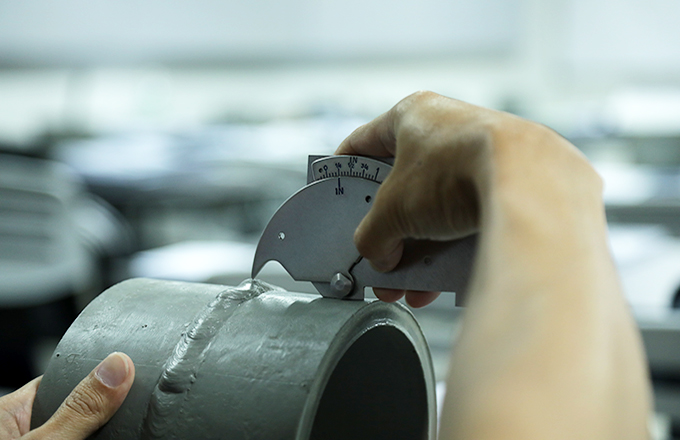What to Get out of a Comprehensive Welding Inspection Milwaukee Process
What to Get out of a Comprehensive Welding Inspection Milwaukee Process
Blog Article

Discovering the Different Approaches and Standards of Welding Examination for Achieving Compliance and Reliability in Design Applications
The significance of welding assessment in engineering applications can not be overstated, as it works as a critical secure for making sure architectural honesty and compliance with industry standards. Various approaches, consisting of aesthetic evaluation and advanced non-destructive screening strategies, offer crucial insights into the high quality of welds. Additionally, adherence to established regulative requirements such as those from AWS and ASME develops a framework for liability and quality. However, the landscape of welding inspection is consistently evolving, prompting a more detailed examination of emerging techniques and their ramifications for design integrity. What might these growths entail for future projects?
Value of Welding Inspection
Welding evaluation plays an essential duty in ensuring the stability and safety of bonded structures. The importance of welding examination can not be overstated, as it offers as a protect versus possible failings that could result from poor welding techniques.
In addition, welding inspection is important for preserving quality control throughout the welding procedure. It makes sure that the welds meet the required mechanical and physical residential or commercial properties required for their intended applications. Routine evaluations likewise foster a society of accountability and continuous renovation within welding operations, motivating adherence to ideal methods and sector criteria.
In regulated sectors such as manufacturing, building and construction, and aerospace, rigid welding inspection protocols are mandated to adhere to lawful and safety demands. Ultimately, efficient welding evaluation not only safeguards human life and residential or commercial property however also enhances the longevity and dependability of welded structures, making it a vital aspect of design and building and construction.

Typical Welding Inspection Approaches
A selection of evaluation approaches are used to analyze the top quality and integrity of welds, each customized to spot certain kinds of problems. Among the most common techniques is aesthetic inspection, which involves an extensive exam of the weld surface to identify visible problems such as splits, undercuts, and inadequate combination. This method is typically the very first step in the assessment process due to its simpleness and cost-effectiveness.
One more commonly made use of approach is radiographic inspection, where X-rays or gamma rays pass through the weld to expose inner problems. This technique is especially reliable for identifying porosity and inclusions within the weld product. Similarly, ultrasonic screening employs high-frequency acoustic waves to identify internal problems, supplying a detailed evaluation of the weld's honesty.
Additionally, magnetic particle inspection is made use of for ferromagnetic products, allowing for the detection of surface and near-surface issues by observing and using magnetic fields particle patterns. Last but not least, dye penetrant screening involves applying a liquid dye to the weld surface, revealing cracks and other interruptions upon examination. Each of these methods plays a critical duty in guaranteeing weld quality and conformity with industry requirements
Non-Destructive Checking Methods
Non-destructive screening (NDT) strategies are essential devices in the analysis of weld high quality, allowing assessors to examine the stability of welded joints without triggering damages to the materials. Different NDT approaches are used to identify possible problems, making sure that welds fulfill the required requirements for security and performance.
Among the most common methods is ultrasonic testing (UT), which uses high-frequency sound waves to find internal defects such as splits or gaps. Radiographic screening (RT) utilizes X-rays or gamma rays to create photos of welds, disclosing any kind of gaps within the material. Magnetic fragment screening (MT) is efficient for spotting surface and near-surface flaws in ferromagnetic products via the application of magnetic areas and contrasting bits.
Liquid penetrant screening (PT) is an additional extensively made use of method that entails applying a dye to the surface area of the weld, which permeates right look at here into any type of splits, making them visible under ultraviolet light. Each of these methods provides unique advantages and constraints, and the choice of an ideal technique is vital to accomplishing precise evaluations of weld honesty. Inevitably, the execution of NDT strategies considerably adds to the dependability and safety of design applications.

Regulatory Standards and Compliance
In the world of welding evaluation, adherence to regulative requirements and conformity is paramount to guarantee the security and reliability of bonded frameworks (Welding Inspection Milwaukee). Different organizations, including the American Welding Culture (AWS), the American Culture of Mechanical Engineers (ASME), and the International Organization for Standardization (ISO), have actually developed guidelines that control welding practices and inspection treatments. These criteria give a framework for quality assurance, outlining the needed credentials for assessors and the approaches for evaluating weld integrity
Compliance with these regulative requirements not just boosts the architectural stability of welded assemblies yet likewise minimizes risks connected with failures, which can have devastating consequences. Examinations should be carried out utilizing defined treatments, consisting of aesthetic, ultrasonic, and radiographic approaches, to ensure that welds meet defined standards.
Moreover, adherence to these criteria is often required by law, specifically in markets such as production, building, and aerospace. Regular audits and accreditations are vital to maintain conformity, therefore cultivating a culture of safety and quality within companies. Ultimately, regulative criteria and compliance function as the backbone of trustworthy welding examination techniques, making sure that crafted structures satisfy both efficiency assumptions and safety and security requirements.
Finest Practices for Welding Assessment
While keeping compliance with regulative standards is critical, applying ideal methods for welding evaluation better view publisher site enhances the security and integrity of welded structures. Reliable welding assessment starts with complete preparation, that includes comprehending the specific demands of each job and making certain assessors are trained in relevant approaches and standards.
Making use of an extensive assessment checklist helps to make sure all crucial elements are assessed, such as weld size, infiltration, and aesthetic issues. Non-destructive screening (NDT) techniques, such as ultrasonic or radiographic testing, ought to be utilized where suitable, giving an extra in-depth examination of weld high quality without jeopardizing the integrity of the materials.
Documents plays a substantial function in best techniques; keeping precise records of evaluations, including pictures, test results, and conformity reports, makes sure responsibility and facilitates future assessments. In addition, promoting a culture of open communication between examiners and welders can cause very early identification of Full Article prospective issues, advertising prompt rehabilitative activities.
Final Thought
In summary, the execution of rigorous welding examination techniques and adherence to established criteria are crucial for ensuring conformity and reliability in design applications - Welding Inspection Milwaukee. Strategies such as visual inspection, radiographic testing, and ultrasonic testing act as crucial tools in identifying flaws and keeping quality guarantee. By fostering a culture of responsibility and quality, companies can boost the integrity and longevity of welded structures, eventually adding to the security and effectiveness of design jobs
Numerous approaches, consisting of aesthetic evaluation and advanced non-destructive testing strategies, supply vital understandings right into the quality of welds.Welding assessment plays a crucial role in making certain the honesty and safety and security of bonded structures.A range of evaluation approaches are used to evaluate the high quality and stability of welds, each customized to discover details types of defects.One more widely utilized approach is radiographic assessment, where X-rays or gamma rays permeate the weld to disclose interior flaws.In the realm of welding inspection, adherence to regulative requirements and compliance is extremely important to make certain the security and dependability of bonded frameworks.
Report this page